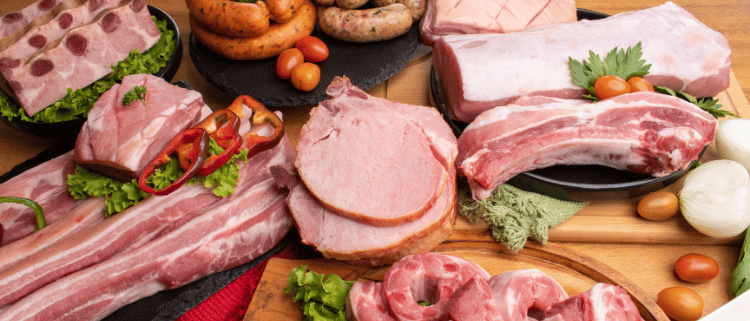How organic Zinc can support the pork production
Adaptation of pig production is needed to answer the customer demand for sustainably produced and high-quality products. Supplementation with a highly available zinc source can be a good strategy to reduce losses during chilling of the carcass and oxidation of cooked meat, retaining pork quality better over time about one third of global meat consumption is pork, only second after chicken. Due to its religious constraints and historic availability, the consumption of pork products varies widely between regions, but in both Europe and Asia it is the most consumed meat.
Author: Mieke Zoon, Product Manager, Minerals, published in Feed & Additive Magazine, July 2022
Recent research into feeding the growing global human population has highlighted the potential of pigs in the recycling of by-products (mainly food waste and co-products) for food production. Their ability to turn by-products into food and manure, pigs return nutrients back into the food production system that would otherwise be lost (2, 3).
Pork is often consumed in processed forms (minced meat, bacon, sausages, dry-cured or cooked ham and more), that have their origins related to preserving methods. Today, the main differentiation of pork products is made based on taste, origin and production standards. However, pork products still need to be attractive and made safe over time for consumers. Due to the variety in final products and changing preferences of the consumer, targeted meat quality can differ and may change over time .
The impact of several factors influencing meat quality in general and pork quality specifically have been studied in detail. For example, genetics, dietary lipid profile, preslaughter and slaughter conditions. More research is still needed to reduce oxidative stress in meat after slaughter as it affects its ability to be processed and stored. Examples of characteristics that are influenced by oxidative stress, are fat quality and water holding capacity (1).
Zinc is an essential nutrient for many physiological processes in the organism supporting health and good growth and development. Major functions of zinc on a cellular level are catching free radicals and preventing lipid peroxidation as part of the antioxidant system (5). Therefore, a deficiency of zinc in pigs may affect the pork quality after slaughter and processing.
A chemically well-defined range of metal glycinates (6) with scientifically proven results in major livestock species has already shown to be efficient to support pig production. By supplementing through- out the production cycle from gestating sows until slaughter of their progeny, sow fertility improved and piglets with low birth weight reduced, while growth performance and slaughter characteristics improved as well (7).
More specifically for pork quality, recent data shows that supplementing zinc from zinc-glycinate in the finishing phase of fattening pigs reduced the chilling losses of their carcasses after slaughter (Figure 1) (8).
The meat from pigs supplemented with zinc-glycinate showed less lipid peroxidation after cooking, especially with the lower dose of zinc-glycinate (Figure 2) (8). The lipid stability in cooked pork is essential for the quality and taste of cooked pork products.
Pork is and will be an important source of animal protein, and zinc can be part of a nutritional strategy to improve the quality of pork. Adaptation of pig production is needed to answer the customer demand for sustainably produced and high-quality products. Supplementation with a highly available zinc source can be a good strategy to reduce losses during chilling of the carcass and oxidation of cooked meat, retaining pork quality better over time.
References
- Lebret, B. and M. Čandek-Potokar, 2022a: Re- view: Pork quality attributes from farm to fork. Part I. Carcass and fresh meat. Animal 16: 100402.
- Van Zanten, H. H. E., M. Herrero, O. Van Hal, E. Röös, A. Muller, T. Garnett, P. J. Gerber, C. Schader and I. J. M. De Boer, 2018: Defining a land boundary for sustainable livestock Glob- al Change Biology 24: 4185-4194.
- Van Zanten, H. E., M. K. Van Ittersum and
- M. De Boer, 2019: The role of farm animals in a circular food system. Global Food Security 21: 18–22.
- Lebret, B. and M. Čandek-Potokar, 2022b: Re- view: Pork quality attributes from farm to Part
- Processed pork Animal 16: 100383.
- Sloup, , I. Jankovská, S. Nechybová, P. Peřinková and I. Langrová, 2017: Zinc in the animal organism: a review. Scienta Agriculturae Bohemica, 48(1): 13-21.
- Oguey, S., A. Neels and H. Stoeckli-Evans, 2008: Chemical identity of crystalline trace mineral glyci- nates for animal nutrition. Trace elements in animal production systems – Short communications: 245-
- Fuchs, B., U. Geier and P. Schlegel, 2008: Trace mineral supplementation in pig production: Less is better. Feed Magazine Kraftfutter number 9-10.
- Natalello, A., H. Khelil-Arfa, G. Luciano, M. Zoon, R. Menci, M. Scerra, A. Blanchard, F. Manga- no, L. Biondi and A. Priolo, 2022: Effect of different levels of organic zinc supplementation on pork quality. Meat Science 186: 108731.



